
Assembly, Installation, Care,
Maintenance, and Use Instructions
Questions? Issues?
We are here to help!
Phone: (1) 718-535-1800
Email: suppor[email protected]om
Sound Around, Inc.
1600 63rd. Street Brooklyn, NY 11204 USA
Please
CALL us
if you have
any issues.
Read these materials prior to assembling and
using this Trampoline/Trampoline enclosure.

Home Backyard Sports Trampoline
SLTRA12BL
Large Outdoor Jumping Fun Trampoline
for Kids/Children, Safety Net Cage (12’ ft.)

WARNING
YOU MUST CAREFULLY READ AND UNDERSTAND THESE OPERATING
INSTRUCTIONS BEFORE PUTTING TOGETHER AND USING THIS TRAMPOLINE.
KEEP THESE OPERATING INSTRUCTIONS SO THAT YOU CAN REFER BACK TO
THEM LATER OR PASS THEM ON IF YOU SELL THIS TRAMPOLINE.
THIS TRAMPOLINE MAY ONLY BE USED TOGETHER WITH THE NET THAT COMES
WITH IT.
ATTENTION!
• Only for domestic use
• This toy is designed for outdoor use
• Trampoline over 20 in. (51cm.) tall are not recommended for children under 6
years of age
• Only one user at a time. Risk of collision
• Product dimensions:
Jumper 180: Ø 182.9 cm X (H) 239 cm
Jumper 251: Ø 251.5 cm X (H) 239 cm
Jumper 305: Ø 305.0 cm X (H) 256 cm
Jumper 366: Ø 366.0 cm X (H) 270 cm
Jumper 430: Ø 426.7 cm X (H) 270 cm
INTRODUCTION
Before you use this trampoline, carefully read all information in these operating
instructions and make sure you follow it. Just like any other leisure activity, there
is a risk of injury. To avoid injuries, ensure that you observe the corresponding
safety regulations and tips. Misuse of this trampoline is dangerous and can lead
to serious injuries!
• Trampolines are bouncy appliances that transport the user into unusual heights
and dierent postures.
• Check the trampoline before every use for a worn mat or loose or missing parts.
• These operating instructions provide tips on the correct assembly, care and
maintenance, safety, warnings and the right jumping techniques. All users and
spotters must familiarize themselves with these operating instructions. Everyone
who decides to use this trampoline must be aware of their own limitations with
regard to the various jumps on this trampoline.
www.SereneLifeHome.com
2

WARNING
CONSULT YOUR DOCTOR PRIOR TO ANY KIND OF PHYSICAL TRAINING
THE TRAMPOLINE SHOULD ONLY BE USED BY ONE PERSON AT A TIME!
IF THERE ARE SEVERAL TRAMPOLINISTS, THERE IS A GREATER RISK OF
BREAKING YOUR NECK, LEG OR BACK.
FALLING ON YOUR HEAD OR NECK MAY RESULT IN PARALYSIS OR DEATH!
DO NOT PERFORM ANY SUMMERSAULTS AS THIS INCREASES THE RISK OF
FALLING ON YOUR HEAD OR NECK!
WARNING
Assembly and Installation Instructions
• Adequate overhead clearance is essential. A minimum clearance of 24 ft. from
ground level is recommended. Provide clearance for wires, tree limbs, and other
possible hazards.
• Lateral clearance is essential. Place the trampoline away from walls, structures,
fences, and other play areas. Maintain a clear space on all sides of the trampoline.
• Place the trampoline on a level surface before use.
• Use the trampoline in a well-lighted area. Articial illumination may be required for
indoor or shady areas.
• Secure the trampoline against unauthorized and unsupervised use.
• Remove any obstructions from beneath the trampoline.
• The owner and supervisors of the trampoline are responsible to make all users
aware of practices specied in the use instructions.
Use Instructions
• Do not attempt or allow somersaults. Landing on the head and neck can cause
serious injury, paralysis, or death, even when landing in the middle of the bed.
• Do not allow more than one person on the trampoline at a time. Use by more than
one person at the same time can result in serious injuries.
• Use trampoline only with mature, knowledgeable supervision.
• Trampolines over 20 in. (510 mm) tall are not recommended for children under 6
years of age.
• Inspect the trampoline before use. Make sure the frame padding is correctly and
securely positioned. Replace any worn, defective, or missing parts.
• Climb on and off the trampoline. It is a dangerous practice to jump from the
trampoline to the oor or ground when dismounting, or to jump onto the trampo-
line when mounting. Do not use the trampoline as a springboard to other objects.
www.SereneLifeHome.com
3

• Stop bounce by exing knees as feet come in contact with the bed. Learn this skill
before attempting others.
• Learn fundamental bounce and body positions thoroughly before trying more
advanced skills. A variety of trampoline activities can be carried out by performing
the basic fundamentals in various serious and combinations, performing one
fundamental after another, with or without feet bounces between them.
• Avoid bouncing too high. Stay low until bounce control and repeated landing in
the center of the trampoline can be accomplished. Control is more important than
height.
• While keeping the head erect, focus eyes on the trampoline toward the perimeter.
This will help control bounce.
• Avoid bouncing when tired. Keep turns short.
• Properly secure the trampoline when not in use. Protect against unauthorized use.
If a trampoline ladder is used, the supervisor should remove it from the trampoline
when leaving the area to prevent the unsupervised access by children under 6 years
of age.
• Do not use or stand near the trampoline in windy or gusty conditions. A trampoline
can become airborne when exposed to sustained wind or gusting wind conditions.
This can result in serious injury, paralysis, or death, as well as property damage. To
reduce these risks, disassemble the trampoline and enclosure and store them until
weather conditions improve. Anchoring a trampoline frame may prevent the
trampoline from moving as a result of the wind, but even anchored trampolines can
become airborne or damaged. Consult a qualied contractor to determine what
type of anchor works best in your location.
• Keep objects away which could interfere with the performer. Maintain a clear area
around the trampoline.
• Do not use the trampoline while under the inuence of alcohol or drugs.
• For additional information concerning the trampoline equipment, contact
manufacturer or instructor.
• For information concerning skill training, contact a trainer certication organization.
• Bounce only when the surface of the bed is dry. Wind or air movement should be
calm to gentle. The trampoline must not be used in gusty or severe winds.
• Read all instructions before using the trampoline. Warnings and instructions for the
care, maintenance, and use of this trampoline are included to promote safe,
enjoyed use of the equipment.
www.SereneLifeHome.com
4

WARNING
• Do not attempt or allow somersaults, landing on the head or neck can cause
serious injury, paralysis, or death, even when landing in the middle of the bed.
• Do not allow more than one person on the trampoline. Use by more than one
person at the same time can increase the chance of injury.
• Use trampoline only with mature, knowledgeable supervision.
Care and Maintenance Instructions
Inspect the trampoline before each use and replace any worn, defective, or
missing parts. The following conditions could represent potential hazards:
• Missing, improperly positioned, or insecurely attached frame padding.
• Punctures, frays, tears, or holes worn in the bed or frame padding.
• Deterioration in the stitching or fabric of the bed or frame padding.
• Ruptured springs.
• A bent or broken frame.
• A sagging or worn bed.
• Sharp protrusions on the frame or suspension system.
IF YOU COME ACROSS ANY OF THE ABOVE CONDITIONS OR ANYTHING ELSE
THAT YOU THINK COULD LEAD TO ANY DAMAGE TO A USER, THE TRAMPOLINE
MUST BE DISMANTLED OR PUT OUT OF OPERATION UNTIL THE PROBLEM(S)
HAS/HAVE BEEN SOLVED.
WIND
In the event of strong wind, the trampoline can be blown away. If you are expecting
strong wind, the trampoline must be placed in a sheltered position or dismantled.
Another option is to secure the round outer part (top frame) of the trampoline in the
ground with the help of ropes and stakes. Make sure that the connection at the
bottom reaches to the middle of a frame part. For a secure positioning, at least three
connections must be placed in the ground. Don't just secure the feet of the trampoline
in the ground as these can be pulled out of the frame holders.
Trampolines higher than 51cm are not suitable for use by children under the age of
three. DO NOT USE INSIDE.
www.SereneLifeHome.com
5

INFORMATION ON USING THE TRAMPOLINE
• To brake a jump, you just have to rapidly bend your knees before these come into
contact with the trampoline mat. This technique should be practiced while learning
the individual basic jumps. The braking technique should always be used if you lose
your balance or control of your jump.
• First get used to the feeling of jumping on the trampoline. Concentrate on the basic
body positions and practice every jump (the basic jumps) until you can perform
them easily and in a controlled manner.
• First learn the easiest jump and master this before moving on to a more difficult
and more advanced jump. A controlled jump is a jump in which your starting and
landing point on the mat are identical. If you move on to the next jump without
mastering the rst, you risk injuring yourself.
• Don't jump too long on the trampoline as exhaustion increases the risk of injury.
Only jump for a short time and then allow others to take part in the fun!
The trampoline should only be used by one person at a time.
• The trampolinist should wear T-shirt, shorts or a pull over, as well as proper gym
shoes, heavy socks or go barefoot. If you are a beginner, to protect yourself from
scratches and grazes you should wear a long-sleeve T-shirt and long pants until you
have mastered the correct landing positions and forms. When on the trampoline do
not wear shoes with hard soles, such as tennis shoes, as these excessively wear
down the material of the mat.
• Always climb properly on and off the trampoline to avoid injury. To get on properly,
put your hand on the frame and climb on or roll yourself on to the frame, across the
springs and on to the trampoline mat. Always remember to put your hands on the
frame when getting on and off. Don't grab or climb directly on to the frame padding.
To correctly dismount, move to the side of the trampoline, put your hand on the
frame to support It and climb from the mat on to the oor. Small children should be
supported when getting on and off the trampoline.
• Don't practice any daredevil jumps on the trampoline as this increases the risk of
injury. The key for safety and fun on the trampoline is the control and mastery of
the various jumps. Never try to jump higher than another trampolinist! Never use
the trampoline on your own without a spotter.
www.SereneLifeHome.com
6

TYPES OF ACCIDENTS
• Getting on and o: Be very careful getting on and off the trampoline. Do NOT get
on the trampoline by grabbing hold of the frame padding, standing on the springs,
or jumping from another object (e.g.a terrace, a roof or a ladder) on to the trampoline
mat. This increases the risk of injury! Do NOT get off the trampoline by jumping on
to the oor, irrespective of the structure of the oor. If little children are jumping on
the trampoline, they may need help getting on and off.
• Consumption of alcohol or medications: Do NOT consume alcohol or medication
if you use this trampoline! This increases the risk of injury as these foreign substances
can affect your judgment, your reaction time, and your overall body control.
• One trampolinist at a time: If there are several trampolinists on the trampoline
(more than one trampolinist at the same time on the trampoline), this increases
your risk of Injury. Injuries can occur if you fall off the trampoline, lose control,
collide with another trampolinist, or land on the springs. In general, the lightest
person on the trampoline is the one to be injured.
• Touch the frame or the springs: When jumping on the trampoline, stay in the
MIDDLE of the mat. This decreases the risk of injury by landing on the frame or
springs. The frame padding must always cover the trampoline frame. Do NOT jump
or climb directly on the frame padding as it is not suitable for bearing the weight of
a person.
• Loss of control: Do not try ANY (difficult) exercises before mastering the previous
exercise or if you have just starting learning how to jump on a trampoline. Otherwise,
you increase your risk of landing on the frame, on the springs, or even outside of the
trampoline altogether. A controlled jump is a jump in which your starting and landing
point on the mat are identical. If you lose control when jumping on the trampoline,
bend your knees as you land. This enables you to regain control and stop the jump.
• Somersaults: Do not perform ANY somersaults (front or backwards) on this tram-
poline. If you make a mistake when doing a somersault, you can land on your head
or neck. This can lead to a broken neck or back, which could result in death or paralysis.
• Other objects: Do NOT use the trampoline if animals, other people, or any objects
are under the trampoline. This can otherwise increase the risk of injury. Don't hold
ANY objects and do NOT put anything on the trampoline while someone is jumping
on it. Pay attention to what is over your head when you are jumping on the trampo
line. Branches, cables, and other objects above the trampoline increase the risk of
injury.
• Poor maintenance of the trampoline: A trampoline in poor condition increases
your risk of injury. Please check the trampoline before every use for bent steel tubes,
loose or broken springs and the general stability of the trampoline.
www.SereneLifeHome.com
7

• Weather: When using the trampoline, pay attention to the weather.
When the trampoline mat is wet, the trampolinist can slip and get injured. If it is too
windy, the trampolinist can lose control.
TIPS TO REDUCE THE RISK OF ACCIDENTS
• The role of the trampolinist in the prevention of accidents:
It is vital to keep control while jumping. Do NOT move on to more complicated,
more difficult exercises before mastering the basic jumps. Education is also very
important for safety. Read, understand, and practice all safety precautions and
warnings before the use of the trampoline. A controlled jump is a jump in which
your starting and landing point on the mat are identical. For further safety tips and
instructions, please contact a qualied trampoline teacher.
• The role of the spotter In the prevention of accidents:
Spotters must understand and implement all safety rules and guidelines. The spotter
is responsible for providing advice and instructions to all trampolinists on the
trampoline. If there are no or sufficient spotters available, the trampoline should
be stored in a safe place, dismantled to prevent unauthorized usage or covered
with a heavy tarpaulin that is secured with a chain or a lock. The spotter is also
responsible for ensuring that the safety badge is attached to the trampoline and
that the trampolinists are informed of the warnings and instructions.
TRAMPOLINE SAFETY INFORMATION
TRAMPOLINIST:
• Do not use the trampoline when under the inuence of drugs or alcohol.
• When using the trampoline, trampolinists may not carry any hard or sharp objects
with them.
• Get off the trampoline carefully and in a controlled manner. Never jump on or off
the trampoline and never use the trampoline to jump on or into another object.
• First always learn the basic jumps and master every single jump this before moving
on to more difficult jumps. Refer to the section on Basic Trampoline Jumps to
learn the basics.
• To stop the jump, bend your knees when you land on the mat with your feet.
• Always keep control while jumping on the trampoline. A controlled jump is a jump
in which your starting and landing point on the mat are identical. If you ever feel
you are losing control, try to stop the jump.
• Do not jump for a long time or perform very highjumps right after each other.
• Focus your eyes on the mat to ensure you maintain control. Otherwise, you risk
losing balance or control.
www.SereneLifeHome.com
8

• The trampoline should only be used by one person at a time.
• When the trampoline is used by children, there must always be a spotter.
SPOTTERS:
Familiarize yourself with the basic jumps and safety information. To avoid or reduce
the risk of injury, implement all safety regulations and ensure that new trampolinists
learn the basic jumps before attempting more difficult, advanced jumps.
• All trampolinists must have a spotter Irrespective of their skills and age.
• Never use the trampoline if it is wet, damaged, dirty or worn. The trampoline should
be checked before a trampolinist begins jumping.
• Keep all objects far away that could get in the way of the trampolinist. Pay attention
to what is over, under and around the trampoline.
• The trampoline should be secured if it is not in use in order to prevent unauthorized
usage and usage without a spotter.
LESSON PLAN
The following lessons are suggested for learning of the basic steps and jumps before
passing to more difficult and more complicated jumps. Read and understand all
safety information before actually getting on the trampoline and using it. In addition,
the spotter and pupil should fully discuss body movements and trampoline safety
information and the spotter should perform a demonstration.
Lesson 1
A. Performing the right techniques for getting on and off the trampoline
B. Performing and practicing the basic jumps
C. Stopping (see jump demonstrations) with exercise. Learning to stop on command.
D. Hand and knee demonstration and practice. The focus should be placed on the
four-point landing and position.
Lesson 2
A. Repetition and practice of the techniques learned in Lesson 1.
B. Demonstration of knee jump and practice. Learn to go up and down on your knees
before attempting to perform a half twist to the left and right
C. Seat drop demonstration and practice. Learn the basic seat drop and follow it with
a knee drop with hands and knees;
D. Repetition
Lesson 3
A. Repetition and practice of the skills and techniques learned in the previous lessons.
B. Front drop -to avoid grazes on the mat and to teach the front drop position, all
pupils should be instructed to lie on their stomach (face down to the oor) while
the trainer checks the positions for mistakes that could lead to injuries.
www.SereneLifeHome.com
9

C. Start with the hands and knees drop and then go face down on the mat and get
back on your feet.
D. Practice the hands and knees drop, perform a front drop, get back to your feet,
seat drop, back to your feet. seat drop and back to your feet until you have learned
the routine.
Lesson 4
A. Repetition and practice of the skills and techniques learned in the previous lessons.
B. Half twist
• Start with the front drop position and when you touch the mat either push your
self left or right with your arms and twist your head and shoulders in the same
direction.
• Make sure that during the twist your back is parallel to the mat and your head is
held high.
• After the twist, land In the front drop position.
After completing this lesson, the pupil has learned the basic trampoline jumps.
Trampolinists should be encouraged to try out and develop their own combinations
while paying attention to control and form. To encourage the pupils to develop
combinations, you can play the "JUMP" game. This game has one to 10 players.
Player one starts with a combination. Player two repeats the jump of player one and
adds a jump of their own. The players must perform the combination in the right
order. The rst player to make a mistake is given the letter “S”. The game ends when
someone says the word "JUMP". The nal remaining player is the winner! During the
game, it is important to perform the combinations in a controlled manner and not to
perform any difficult jumps that you haven't already mastered.
Contact a qualied trampoline teacher to improve your trampolining skills.
BASIC TRAMPOLINE JUMPS
BASIC JUMP
1. Start out standing with your feet a shoulder's width
apart, your head held up high and your eyes focused
on the mat.
2. Swing your arms to the front and put in a circular
shape.
3. Put your feet together in mid air and point your toes
down.
4. When you land on the mat, position your feet a
shoulder's width apart.
www.SereneLifeHome.com
10

WARNING
ALWAYS START YOUR JUMP IN THE MIDDLE OF THE MAT. IF YOU ARE MORE
THAN 30CM OUTSIDE OF THE MIDDLE OF THE TRAMPOLINE MAT, IMMEDIATELY
STOP YOUR JUMP!! START YOUR JUMP AGAIN IN THE MIDDLE OF THE MAT!
PUTTING UP THE TRAMPOLINE
There must be a space of at least 7.3m above the trampoline. With regard to the
space at the sides, please ensure that there are no dangerous objects such as
branches, other leisure appliances (e.g. swing, swimming pool), electricity cables,
walls, fences, etc. near the trampoline.
KNEE DROP
1. Start with the basic jump and perform a low jump.
2. Land on your knees with a straight back and upright
body and keep your balance with your arms.
3. Jump back into the basic jumping position by
swinging your arms upwards.
SEAT DROP
1. Land in a at seated position.
2. Place your hands on the mat next to your hips and
keep your elbows relaxed.
3. Return to the upright position by pushing off with
your hands.
FRONT DROP
1. Start with a low jump.
2. Land on your stomach (face down) and hold your
hands and arms stretched out to the front on the
mat. Push yourself off the mat with your arms to
return to standing position.
180-DEGREE SWIVEL
1. Start lying on your stomach.
2. Push yourself off with your right or left arm
(irrespective of the direction in which you would like
to twist).
3. Stretch your head and shoulders in the same direc-
tion and hold your back parallel to the mat and your
head up high.
4. Land on your stomach and return to a standing
position by pushing off with your arms.
www.SereneLifeHome.com
11

To ensure safe use of the trampoline, be aware of the following when choosing
where to put it:
• Make sure it is placed on a level surface.
• The area is well lit
• There are no obstacles on the trampoline
If you do not follow these instructions, you increase the risk of somebody being
injured.
ASSEMBLY INSTRUCTIONS
To assemble this trampoline, you need the special spring tension tool included with
the trampoline. When it is not in use, this trampoline can be easily dismantled and
stored. Please read the assembly instructions before starting. It is recommended that
this product is assembled by at least two people.
BEFORE THE ASSEMBLY
Refer to the parts descriptions and parts numbers on this page. To make it easier for
you, these descriptions and numbers are used in the assembly steps. Make sure that
you have all listed parts. Refer to this page for how to obtain parts that are missing.
Please use gloves during the assembly in order to avoid hurting your hands by
trapping them.
LIST OF PARTS
PURCHASE NO. DESCRIPTlON 180cm 251cm 305cm 366cm 430cm
1 Trampoline mat 1 1 1 1 1
with sewn on eyelets
2 Frame padding/ 1 1 1 1 1
Protective pad
3 Top bar with leg 3 3 4 4 4
supports
4 Top bar 3 3 4 4 4
5 Base/Foot 3 3 4 4 4
6 Vertical leg 6 6 8 8 8
extender
7 Galvanized springs 36 48 64 72 88
8 Spring clamps 1 1 1 1 1
9 Instructions 1 1 1 1 1
10 Fastening Cables 4 6 7 8 0
REMEMBER TO WEAR GLOVES DURINGTHE ASSEMBLY IN ORDER TO AVOID TRAPPING
YOUR HANDS. ATLEAST TWO PEOPLE ARE REQUIREDTO ASSEMBLETHE TRAMPOLINE.
www.SereneLifeHome.com
12

ASSEMBLY INSTRUCTIONS
STEP 1 - Frame Assembly
To assemble the frame, a total of 15 or 20 tube parts are required. All parts with the
same part number are interchangeable and can be used on both the left or right.
To connect the parts, push the thinner end of a tube into the wider end of another
tube. These connections are called connection points. Lay out all parts as shown in
gure 1.1 (Jumper 180/251) and Figure 1.2 (Jumper 305/366/430)
A. Lay out all the frame parts as shown. In this step, pay attention to the order.
B. You must have the following parts:
1. Top bar with leg supports (#3,4 items)
2. Top bar (#4, 4 items)
3. Base (#5, 4 items)
STEP 2 - Assembly of the Support
Push all vertical leg extenders (#6) into the base (#5), as shown in FIGURE 2.
Figure 1.1 Figure 1.2
Figure 2
www.SereneLifeHome.com
13

STEP 3 - Assembly of the top bars
Two people are required to assemble the trampoline in this step. Lift one of the
support components from Step 2 into the vertical position. Insert the top bar with
the leg base into one end of tne support component. Insert the opposite end of the
top bar with leg base into a second support group, as shown in FIGURE 3. Repeat this
step until all support groups have been attached to the top bars with leg base.
Attach the top bar (#3/#4) into the gaps between the vertical leg extenders by
inserting these into the gaps, as shown in FIGURE 4. The upper mail must be
connected by two different supports.
Figure 3
Figure 4
www.SereneLifeHome.com
14

STEP 4 - Attaching the trampoline mat
A. Lay the trampoline mat (#1) in the frame. The logo must face upwards as shown in
FIGURE 5.
B. In total Jumper 180 has -> 36 triangular eyelets sewn on the mat and 36 holes in
the frame of the top bars. Jumper 251 has -> 48 triangular eyelets sewn on the mat
and 48 holes in the frame of the top bars. Jumper 305 has 64 triangular eyelets and
64 holes in the frame. Jumper 366 has 72 triangular eyelets and 72 holes in the
frame and Jumper 430 has 88 eyelets and 88 holes. None of these eyelets or holes
are numbered. Please carefully follow the instructions to ensure correct assembly.
c. Choose a random point on the frame of the top bars (call it ZERO), as shown in
FIGURE 5. First, attach the springs (#7) in the direction and angle (as shown) of the
main frame. The springs only t in one direction, so please be careful. Once you
have attached the hooks of the springs into the main frame, twist the springs in
the direction of the mat, as shown below. Use the specially enclosed tool to pull
together the springs and the mat and attach the hooks to the frame. Please note
the zero point as you will later use this point to attach the springs.
INSTRUCTIONS TO TENSE THE SPRINGS
CAUTION
• Two adults are needed for this step.
• CAUTION: While attaching the springs, do not put your
hands, legs or bodies close to the connection points.
The connection points can trap your hands as the
trampoline tenses.
• Wear heavy work gloves to protect your hands.
• Only use the special spring tension tool provided.
Figure 5
ZERO
www.SereneLifeHome.com
15

D. For Jumper 180, count -> 18 holes (Jumper 251 -> 24; Jumper 305 -> 32; Jumper
366 -> 36; Jumper 430 -> 44) from Point ZERO on the top bars and the
corresponding eyelets to move on to Point 18 for Jumper 180 (Jumper 251 -> 24
Jumper 305 -> 32; Jumper 366-> 36; Jumper 430-> 44). Attach a spring to this
point, as shown In FIGURE 6. Now this is Point B.
E. For Jumper 180, count ->9 holes from Point ZERO on the top bars and the corre
sponding eyelets to move on to Point 9. Attach a spring to this point, as shown in
FIGURE 6. ForJumper 251, please count 12 holes to move on to Point 12; for
Jumper 305, please count 16 holes to move on to Point 16. ForJumper 366, please
count 18 holes to move on to Point 18; and forJumper 430 counts 22 holes to
move on to Point 22. Now this is Point A.
F. For Jumper 180 -> 9 holes from Point ZERO on the top bars and the corresponding
eyelets to move on to Point C. For Jumper 251, please count 12 holes from Point
ZERO; for Jumper 305, please count 16 holes; and for Jumper 366, please count 18
holes; and for Jumper 430, please count 22 holes. Attach a spring to this point, as
shown in FIGURE 6. By this time you should have attached four springs to the points
ZERO, A, B, and C. This even distribution of the tension is important for the correct
and easy assembly of the trampoline ma as shown in FIGURE 6.
Figure 6
www.SereneLifeHome.com
16

G. For Jumper 180, 251 and 305, every eight holes attach a spring to the
corresponding eyelets; for Jumper 366, every nine holes attach a spring; for Jumper
430, every 11 holes attach a spring. For even distribution of the tension and an
easier assembly, each of the springs should be attached to the opposite sides of
the mat of the frame, I.e. rst A1and then C1, B1t hen D1, etc. In addition to the
previously attached springs, you should have springs at ZERO, A1, A, B1, B, C1, C
and D1 ,as shown in FIGURE 7.
H. Jumper 180/251
Attach a spring to hole 4 of the corresponding eyelet and from there attach a spring
every eight holes. For even distribution of the tension and an easier assembly,
each of the springs should be attached to the opposite sides of the mat/the frame,
i.e. rst 4 then 36, 12 then 44, etc. In addition to the previously attached springs,
you should have springs at 4, 12, 20, 28, 36, 44, and 48.
Jumper 305
Attach a spring to hole 4 of the corresponding eyelet and from there attach a
spring every eight holes. For even distribution of the tension and an easier
assembly, each of the springs should be attached to the opposite sides of the
mat/the frame, i.e. rst 4 then 36,12 then 44, etc. In addition to the previously
attached springs, you should have springs at 4,12, 20, 28, 36, 44, 52 and 60.
Figure 7
www.SereneLifeHome.com
17

Jumper 366
Attach a spring to hole 5 of the corresponding eyelet and from there attach a
spring every nine holes. For even distribution of the tension and an easier assembly,
each of the springs should be attached to the opposite sides of the mat/the frame,
i.e. rst 5 then 41,14 then 50, etc. In addition to the previously attached springs,
you should have springs at 5, 14, 23, 32, 41, 50, 59 and 68.
Jumper 430
Attach a spring to hole 6 of the corresponding eyelet and from there attach a
spring every nine holes. For even distribution of the tension and an easier assembly,
each of the springs should be attached to the opposite sides of the mat/the frame,
i.e. rst 6 then 50,17 then 61, etc. In addition to the previously attached springs,
you should have springs at 6,17, 28, 39, 50, 61, 72 and 83.
I. Now attach a spring every four holes or to the corresponding eyelets. For even
distribution of the tension and an easier assembly, each of the springs should be
attached to the opposite sides of the mat/the frame.
J. Then attach all remaining springs by using the same method of counting down
equal holes.
CAUTION
If you realize you have lost count, recount and remove or attach the necessary springs
to obtain the necessary number of springs.
Attaching the frame padding
WARNING
Never use the trampoline without the frame padding attached tie the frame padding
down properly before every use! Make sure that the safety padding of the trampo-
line is securely positioned on the trampoline.
Step 5 - Instructions for assembly of frame padding
A. Place the frame pad (112) on the steel ring frame and tie the elastic to the leg base
as shown in the drawing.
www.SereneLifeHome.com
18

B. Tie one cord (#10) end to one of the eyelets of the jumping mat, then run the other
end of the cord through the mesh of the padding and back to the next eyelet, one
by one until the cord Is nished. Once you have reached the end of the cord, tie it
to the last eyelet in reach. Continue with the next piece of cord by xing it to the
last eyelet of the previous cord and proceed xing the mesh of the padding, until
all the eyelets are rmly connected with the mesh.
Perform a full check of the trampoline to ensure that all parts are correctly attached.
Read the operating instructions in full and ensure that all trampolinists fully under-
stand al lsafety information printed in these operating instructions and on the various
warning signs. Teach all trampolinists the basic jumps described in these operating
instructions.
IMPORTANT NOTE:
Before using the trampoline, make sure that the frame padding is correctly attached
to the frame and that it fully covers the frame and all springs. Do not use the trampo-
line if just one spring or a triangular ring is damaged or missing.
The trampoline is neither designed nor suitable to be installed in-ground.
YOU MUST CAREFULLY READ THE INSTRUCTIONS FOR CARE AND MAINTENANCE
BEFORE USING THE TRAMPOLINE!
A
B
www.SereneLifeHome.com
19
Page is loading ...
Page is loading ...
Page is loading ...
Page is loading ...
Page is loading ...
Page is loading ...
Page is loading ...
Page is loading ...
-
 1
1
-
 2
2
-
 3
3
-
 4
4
-
 5
5
-
 6
6
-
 7
7
-
 8
8
-
 9
9
-
 10
10
-
 11
11
-
 12
12
-
 13
13
-
 14
14
-
 15
15
-
 16
16
-
 17
17
-
 18
18
-
 19
19
-
 20
20
-
 21
21
-
 22
22
-
 23
23
-
 24
24
-
 25
25
-
 26
26
-
 27
27
-
 28
28
Pyle Pro SLTRA10BL.5 Owner's manual
- Type
- Owner's manual
- This manual is also suitable for
Ask a question and I''ll find the answer in the document
Finding information in a document is now easier with AI
Related papers
-
SereneLife SLSPT438 Owner's manual
-
SereneLife SLSWNG100 Owner's manual
-
SereneLife SLSOVSWNG55GR Owner's manual
-
SereneLife SLHP24L Owner's manual
-
SereneLife SLDPS Owner's manual
-
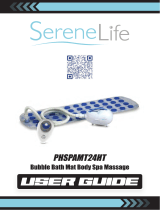 Pyle Pro PHSPAMT24HT User manual
Pyle Pro PHSPAMT24HT User manual
-
SereneLife SLDPCH Owner's manual
-
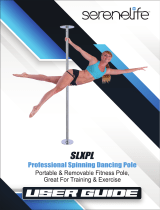 Pyle Pro SLXPL User manual
Pyle Pro SLXPL User manual
-
SereneLife SLPUMP20 Owner's manual
-
SereneLife SLTVC42 Owner's manual
Other documents
-
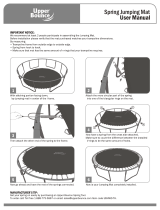 Upper Bounce UBHWD-SP-7.5-15 Operating instructions
Upper Bounce UBHWD-SP-7.5-15 Operating instructions
-
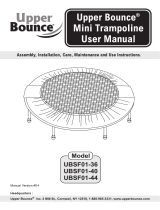 Upper Bounce UBSF01-36 Operating instructions
Upper Bounce UBSF01-36 Operating instructions
-
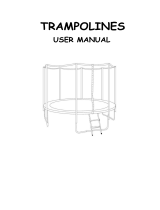 Merax SM000010FAA Operating instructions
Merax SM000010FAA Operating instructions
-
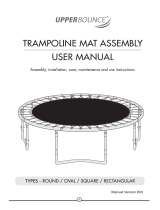 Upper Bounce UBPAD-S-15-G Operating instructions
Upper Bounce UBPAD-S-15-G Operating instructions
-
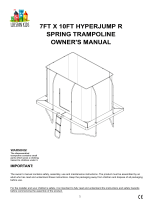 LIFESPAN KIDS 10ft x 7ft HyperJump Rectangle Spring Trampoline Owner's manual
LIFESPAN KIDS 10ft x 7ft HyperJump Rectangle Spring Trampoline Owner's manual
-
Home Beyond BIG12 Operating instructions
-
LIFESPAN KIDS Lil Hopper Childrens 40 Inch Mini Trampoline User manual
-
HOMCOM A93-038 Operating instructions
-
Skywalker SWOP15-B User manual
-
Jumpking JK812GR-V2 Owner's manual


































